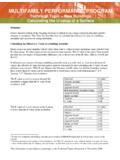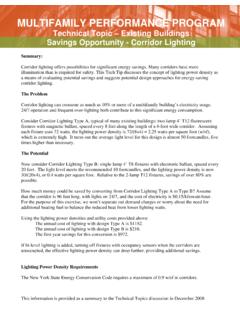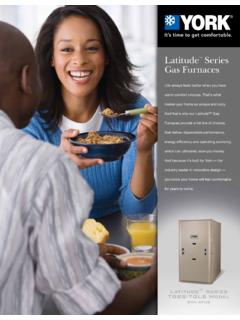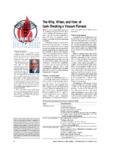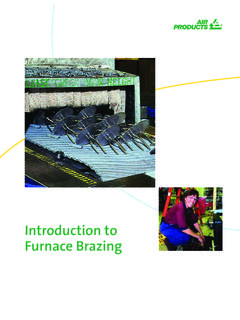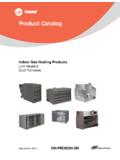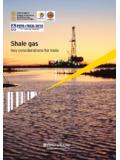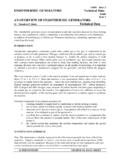Transcription of Gas Furnace Electricity Usage - Taitem Engineering
1 Multifamily Performance Program Gas Furnace Electricity Usage Background A low-rise apartment complex in upstate New York undertook energy improvements through the NYSERDA Multifamily Perfor-mance Program, with replacement of gas furnaces in each apartment as one of the major improvements. Post-construction, substantial gas savings were found to have been delivered, but a significant increase in Electricity use was also observed. This led to an evaluation of the impact of condensing Furnace replacements on blower motor power, with a focus on whether condensing furnaces have higher Electricity Usage than non-condensing furnaces. We measured the electric power draw of several furnaces of each of three different types: Non-condensing furnaces with permanent-split-capacitor (PSC) blower motors Condensing furnaces with PSC blower motors Condensing furnaces with brushless permanent magnet (BPM) blower motors Motor Types The majority of furnaces use PSC motors estimates vary between 75% and 95% likely because these motors are more affordable than BPM motors.
2 Most of these motors have multiple speed taps, one of which is chosen and set by the installer. So, in normal operation, these motors generally run at a constant speed. BPM motors are direct current (DC), variable speed motors that are significantly more efficient than PSC motors, even at low speeds. The Electronically Commutated Motor (ECM) is a regis-tered trademark of General Electric and is the most common brand of BPM motor. Testing and Analysis A power meter was used to record the instantaneous power draw of the furnaces tested. Each unit s total power use was measured, including stand-by power and power drawn by the inducer motor, igniter, and condensate pump. Long-term monitoring was not performed. For furnaces with BPM motors, measurements were taken at both high and low speed. Even though the motors can run at many speeds, they typically run either at high speed or at low speed. Annual projections were performed using a bin analysis to esti-mate Usage based on Furnace runtime calculated for a building with UA = 547 btu/h- F at each of a number of different outdoor temperatures.
3 Results There is a significant increase in Electricity Usage when replac-ing a non-condensing Furnace with a condensing Furnace having a PSC motor, with the average Electricity Usage increasing by approximately 50%. When a non-condensing Furnace is replaced with a condensing Furnace with a BPM motor, the blower Electricity use increases slightly at high fire. But because a typical dual-stage Furnace fires on low fire so much of the time, the annual Electricity Usage for a BPM condensing Furnace is slightly lower than for a non-condensing Furnace . Tables 1, 2, and 3 on the next page show the complete test results. Secondary Sources of Electricity Usage Secondary sources of Electricity Usage include standby energy, draft inducers, igniters, and when installed, condensate pumps. Taken together, these can add from 5% to 20% to the annual Electricity Usage , with 10% being typical. The majority of the added annual electric use is the Electricity the Furnace uses while on standby, presumably for controls.
4 Added Construction Cost Furnaces with BPM motors were found to cost $200 to $800 more than those with PSC motors, with an average cost differ-ence of $400. Modeling For Usage in energy modeling, such as TREAT, the following estimates are recommended, on the basis of annual heating Usage : April 15, 2013 Non-condensing Furnace 6 kWh/MMBtu Condensing Furnace with PSC motor 9 kWh/MMBtu Condensing Furnace with BPM motor 5 kWh/MMBtu Example Assume that a multifamily building consumes 1,300 MMBtu per year for heating and is heated with non-condensing furnaces having an AFUE of 81%. Annual electric Usage can be calculated as follows: Multifamily Performance Program Gas Furnace Electricity Usage April 15, 2013 Furnace Furnace Output (Btu/hr) Blower Power (W/kBtuh) Total Annual kWh Total Electric Usage (kWh/MMBtu) A 80,000 920 10 B 88,000 640 7 C 95,000 700 7 D 100,000 880 9 E 100,000 300 3 F 108,000 260 3 G 160,000 360 4 Average 104,429 580 6 Table 1 Non-Condensing Furnaces with PSC blowers Definitions Blower power Instantaneous blower power used per Furnace heat output.
5 For dual-stage furnaces, there are separate values for the blower power on high fire and on low fire. Total Annual kWh The estimated annual energy Usage of each Furnace if installed in a building requiring 46,500 Btuh to heat at -18 F. Total electric Usage The average Electricity , in watt-hours, per kBtu of heat supplied to the building, In addition to blower motor Electricity , this includes secondary sources of Electricity Usage . Furnace Furnace Output (Btu/hr) (high) (low) Blower Power (W/kBtuh) (high) (low) Total Annual kWh Total Electric Usage (kWh/MMBtu) H 46,500 1,100 11 I 54,000 11 J 67,500 880 9 K 73,000 460 5 L 75,000 700 7 M 90,000 940 10 N 93,000 980 10 O 93,200 63,716 920 10 P 114,000 560 6 Average 78,467 63,716 847 9 Table 3 Condensing Furnaces with BPM blowers Table 2 Condensing Furnaces with PSC blowers Furnace Furnace Output (Btu/hr) (high) (low) Blower Power (W/kBtuh) (high) (low) Total Annual kWh Total Electric Usage (kWh/MMBtu) Q 60,000 24,000 440 5 R 67,500 45,900 700 7 S 74,000 30,000 380 4 T 78,000 31,200 560 6 Average 69,875 32,775 520 5
